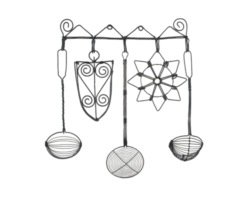Katarína Hallonová
From a historical, economic as well as production point of view, the tinker’s trade is a specific type of folk production in Slovakia. It is one of the youngest crafts historically, and its origins can be traced from the end of the 18th century. It was developed in various specific forms that co-existed together for a long time. The oldest was home production, which involved the whole family (putting wire around new clay vessels). At the same time, this craft developed into a “mobile” form that eventually became dominant and exclusively male (tinkers would repair agricultural tools and damaged clay vessels, they would make simple objects from wire and metal). From the middle of the 19th century, this mobility for many tinkers became permanent emigration from home – to the USA, Canada, Brazil, Argentina, Mexico and Australia. It became a craft performed in workshops and guilds, later an industrial craft. As a result of the political changes in Europe in 1918, as well as a continual introduction of new materials, mainly plastics, this craft started to vanish and after World War II it practically ceased to exist in this classical form.
Wire started to appear again in utilitarian as well as artistic form in the 1960s. After 1990, its development and direction was influenced by annual meetings of tinker masters organized by the Považie Museum in Žilina under the influence of a project for breathing new life into work with wire in Slovakia. In the last decade, the utilitarian form of the craft in the traditional understanding continually shifted to utilitarian-decorative and artistic creation. Apart from folk artistic production, wire has found a place in artistic craft, jewellery and fine arts, often in combination with metal, natural and also utterly non-traditional materials. The character of metal fibres caused this craft to overlap into textile branches. Currently, the museum is in contact with nearly 70 craftsmen and artists who work with wire.
